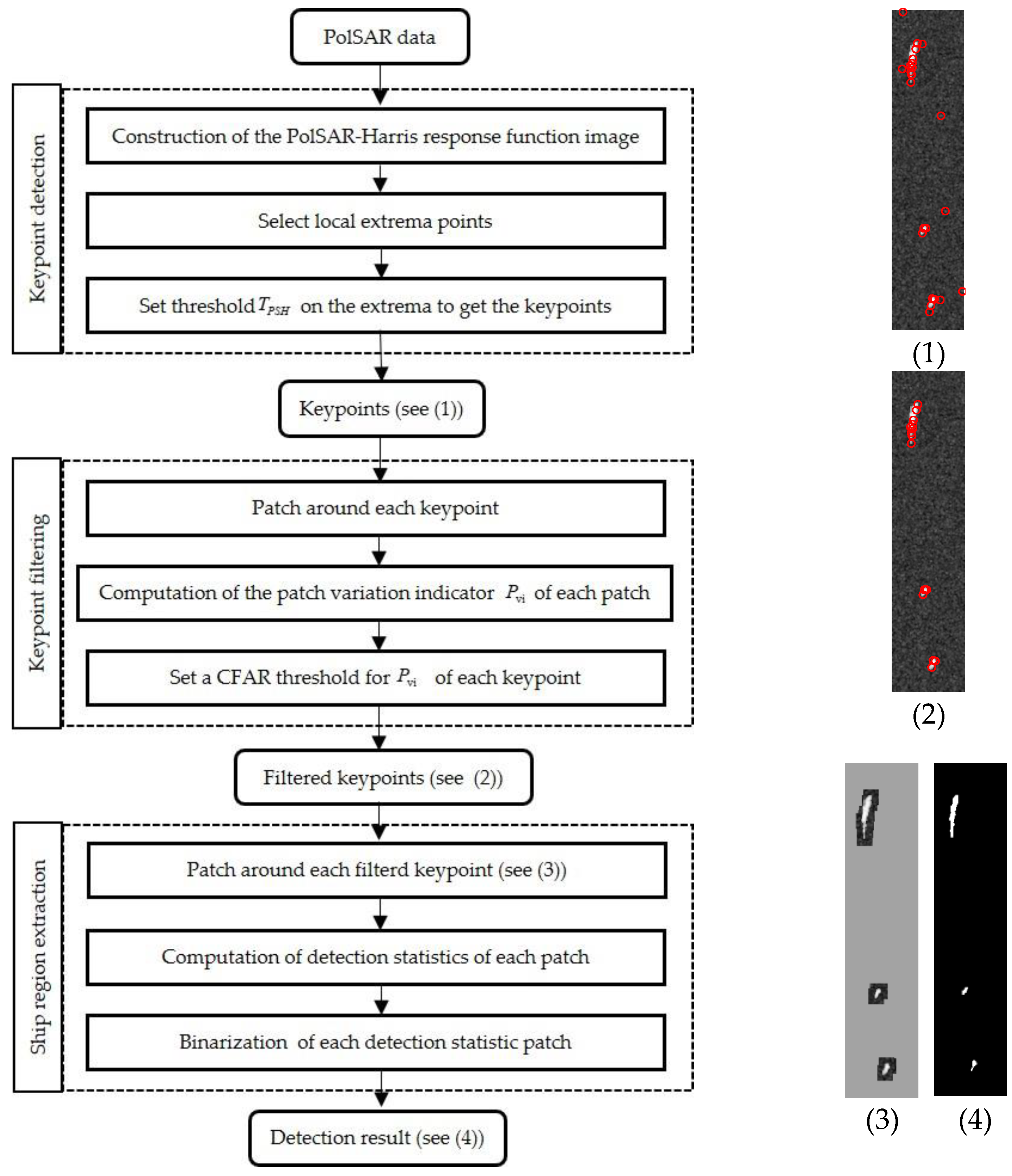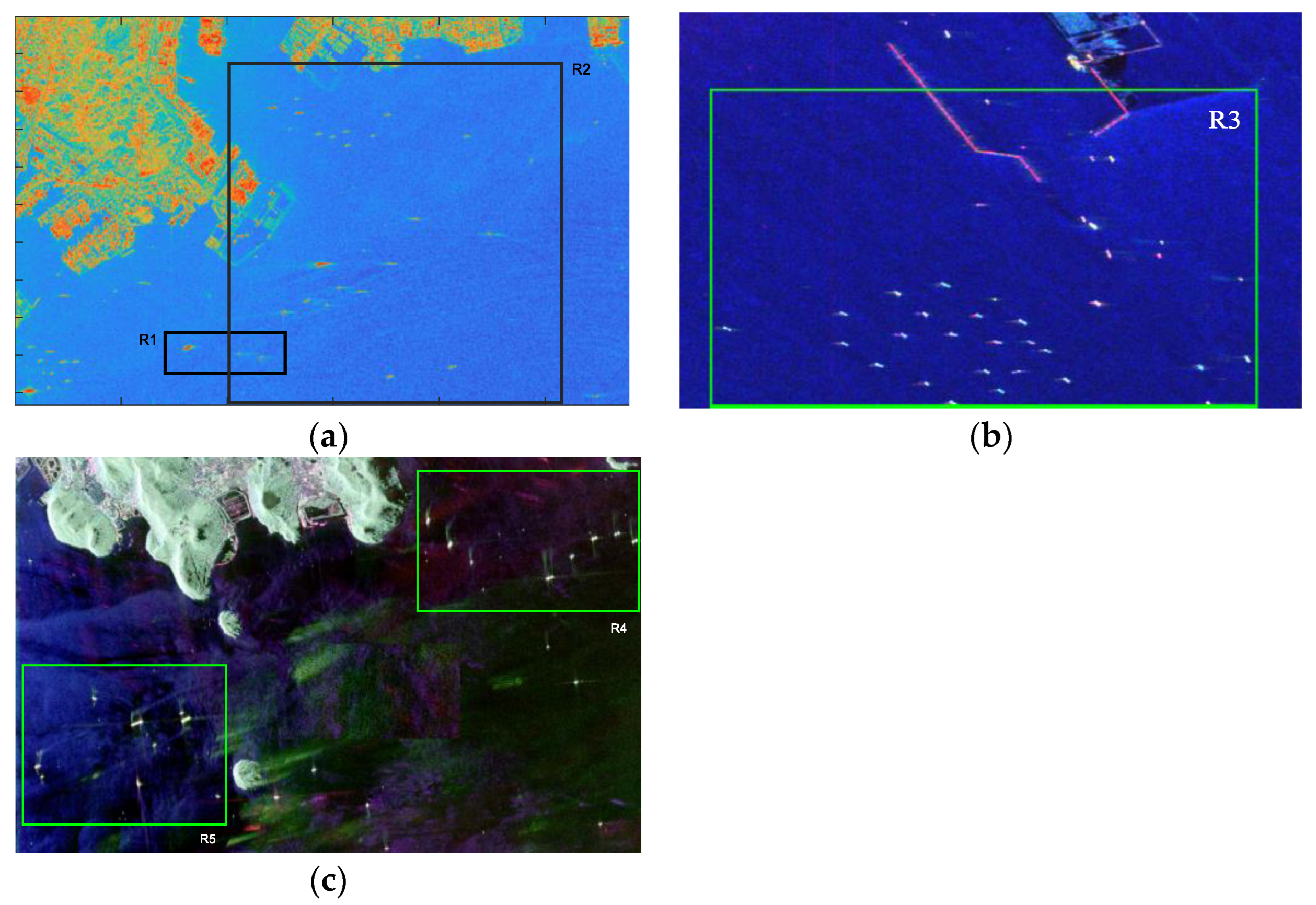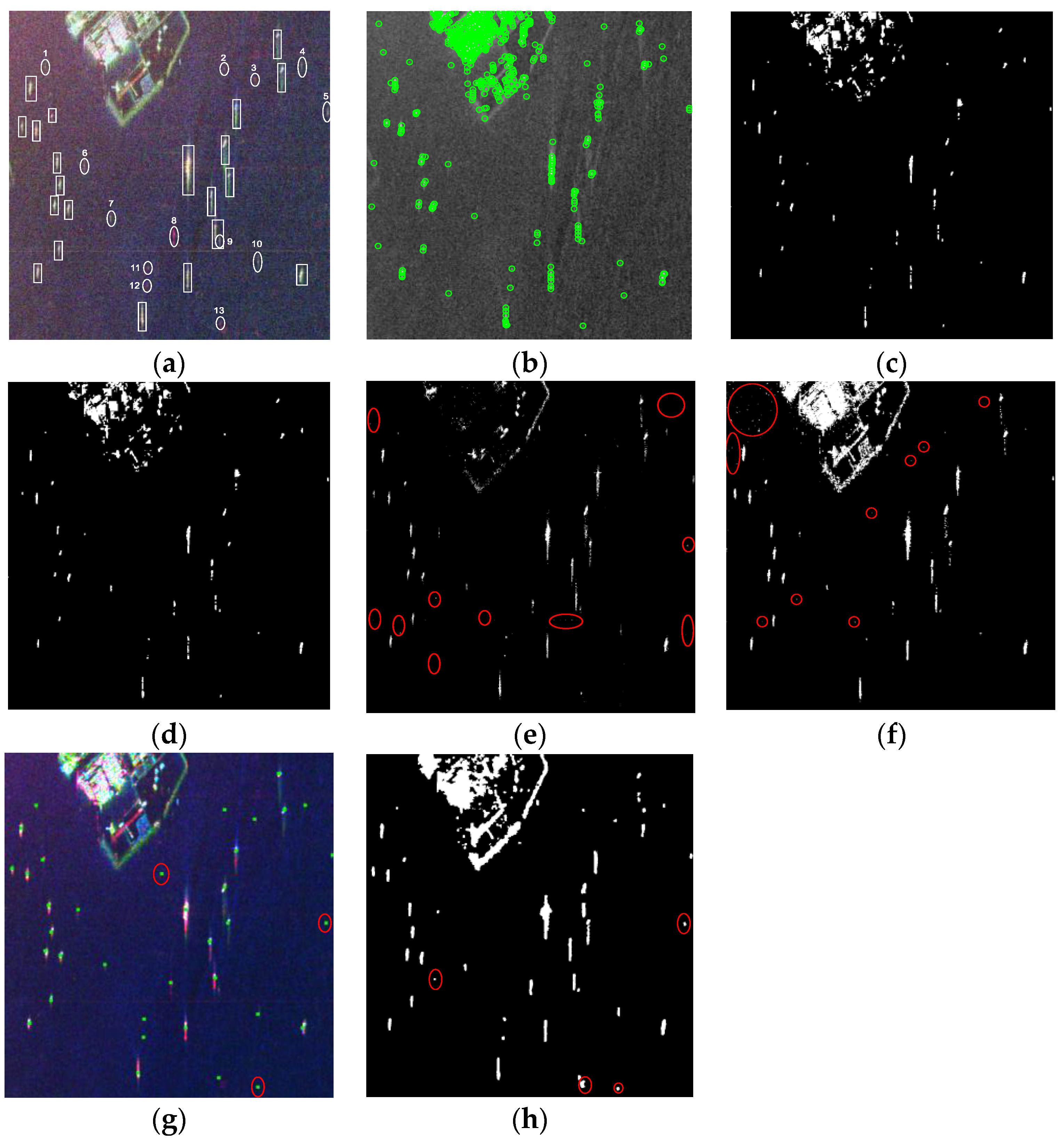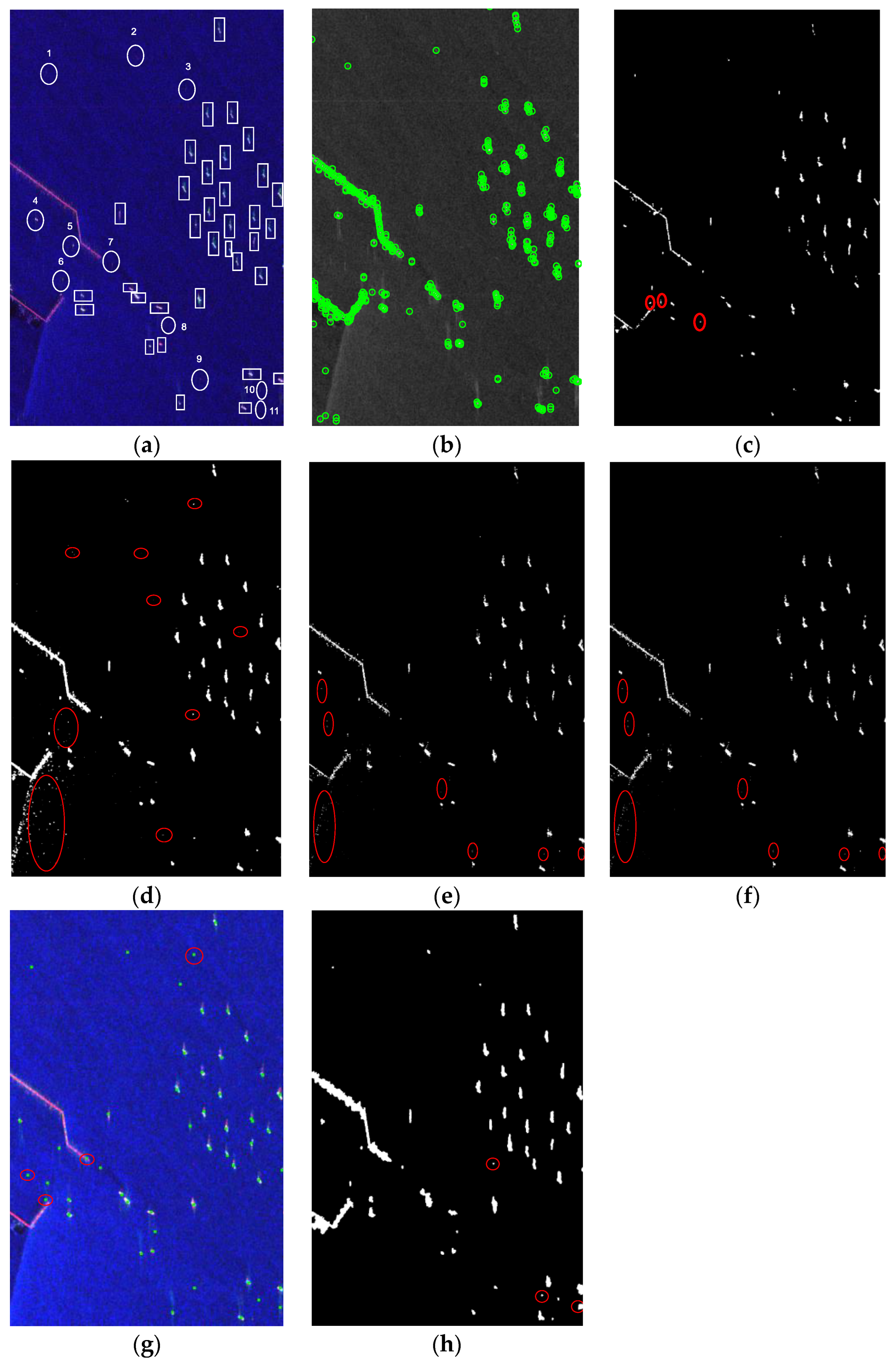PolSAR Ship Detection Based on a SIFT-like PolSAR Keypoint Detector
Abstract
:1. Introduction
2. PolSAR Data and SAR-SIFT Keypoint Detector
2.1. Polarimetric SAR Data
2.2. Original SAR-SIFT Keypoint Detector
3. Ship Detection Method Based on PolSAR-SIFT Keypoint Detector
3.1. PolSAR-SIFT Keypoint Detector
3.2. Ship Detection Based on the Keypoint and Patch Variation Indicator
4. Ship Detection Performance Validation
4.1. Validation of Each Part of the Proposed Method
4.1.1. Keypoint Detection Test
4.1.2. Patch Variation Indicator
4.1.3. Detection Statistic
4.2. Results of Different Ship Detection Methods
5. Conclusions
- (1)
- All the targets in the ground truth are manually marked based on the visual judgment of the Pauli pseudo-color images and analysis of scattering patterns. In order to more accurately verify the detection performance of the proposed method, in the future, we will try to obtain more accurate ground truth through AIS verification, optical picture-assisted verification, etc.
- (2)
- The two data sets used in this paper are both under low- and middle-sea conditions. The method should be validated on more data with complex sea conditions in the future, with a view to identifying deficiencies and improving them.
Author Contributions
Funding
Data Availability Statement
Conflicts of Interest
References
- Novak, L.M.; Burl, M.C.; Irving, W.W. Optimal polarimetric processing for enhanced target detection. IEEE Trans. Aerosp. Electron. Syst. 1993, 29, 234–244. [Google Scholar] [CrossRef]
- Velotto, D.; Nunziata, F.; Migliaccio, M.; Lehner, S. Dual-polarimetric TerraSAR-X SAR data for target at sea observation. IEEE Geosci. Remote Sens. Lett. 2013, 10, 1114–1118. [Google Scholar] [CrossRef]
- Marino, A. A notch filter for ship detection with polarimetric SAR data. IEEE J. Sel. Top. Appl. Earth Obs. Remote Sens. 2013, 6, 1219–1232. [Google Scholar] [CrossRef] [Green Version]
- Yang, D.; Du, L.; Liu, H.; Wang, Y.; Gu, M. Extended geometrical perturbation based detectors for PolSAR image target detection in heterogeneously patched regions. IEEE J. Sel. Top. Appl. Earth Obs. Remote Sens. 2018, 12, 285–301. [Google Scholar] [CrossRef]
- Liu, T.; Yang, Z.; Zhang, T.; Du, Y.; Marino, A. A new form of the polarimetric notch filter. IEEE Geosci. Remote Sens. Lett. 2020, 19, 4001405. [Google Scholar] [CrossRef]
- Wang, Y.; Liu, H. PolSAR ship detection based on superpixel-level scattering mechanism distribution features. IEEE Geosci. Remote Sens. Lett. 2022, 12, 1780–1784. [Google Scholar] [CrossRef]
- He, J.; Wang, Y.; Liu, H.; Wang, N. PolSAR ship detection using local scattering mechanism difference based on regression kernel. IEEE Geosci. Remote Sens. Lett. 2017, 14, 1725–1729. [Google Scholar] [CrossRef]
- He, J.; Wang, Y.; Liu, H.; Wang, N.; Wang, J. A novel automatic PolSAR ship detection method based on superpixel-level local information measurement. IEEE Geosci. Remote Sens. Lett. 2018, 15, 384–388. [Google Scholar] [CrossRef]
- Liu, T.; Yang, Z.; Marino, A.; Gao, G.; Yang, J. PolSAR ship detection based on neighborhood polarimetric covariance matrix. IEEE Trans. Geosci. Remote Sens. 2021, 59, 4874–4887. [Google Scholar] [CrossRef]
- Gu, M.; Wang, Y.; Liu, H.; Wang, P. PolSAR ship detection via a refined polarimetric notch filter. In Proceedings of the CIE International Conference on Radar (RADAR), Haikou, China, 15–19 December 2021. [Google Scholar]
- Gu, M.; Liu, H.; Wang, Y.; Yang, D. PolSAR target detection via reflection symmetry and a Wishart classifier. IEEE Access 2020, 8, 103317–103326. [Google Scholar] [CrossRef]
- Novak, L.M.; Sechtin, M.B.; Cardullo, M.J. Studies of target detection algorithms that use polarimetric radar data. IEEE Trans. Aerosp. Electron. Syst. 1989, 25, 150–165. [Google Scholar] [CrossRef] [Green Version]
- Liu, T.; Jiang, Y.; Marino, A.; Gao, G.; Yang, J. The Polarimetric detection optimization filter and its statistical test for ship detection. IEEE Trans. Geosci. Remote Sens. 2022, 60, 5202218. [Google Scholar] [CrossRef]
- Yang, D.; Du, L.; Liu, H.; Ni, W. Novel polarimetric contrast enhancement method based on minimal clutter to signal ratio subspace. IEEE Trans. Geosci. Remote Sens. 2019, 57, 8570–8583. [Google Scholar] [CrossRef]
- Chen, S.W.; Wang, X.S.; Sato, M. Uniform polarimetric matrix rotation theory and its applications. IEEE Trans. Geosci. Remote Sens. 2014, 52, 4756–4770. [Google Scholar] [CrossRef]
- Chen, S.W.; Wang, X.S. Polarimetric coherence pattern: A visualization tool for PolSAR data investigation. In Proceedings of the IEEE International Geoscience and Remote Sensing Symposium (IGARSS), Beijing, China, 10–15 July 2016; pp. 7509–7512. [Google Scholar]
- Cui, X.C.; Tao, C.S.; Su, Y.; Chen, S.W. PolSAR ship detection based on polarimetric correlation pattern. IEEE Geosci. Remote Sens. Lett. 2021, 18, 471–475. [Google Scholar] [CrossRef]
- Li, H.; Cui, X.; Chen, S. PolSAR Ship detection with optimal polarimetric rotation domain features and SVM. Remote Sens. 2021, 13, 3932. [Google Scholar] [CrossRef]
- Cui, X.; Su, Y.; Chen, S. A saliency detector for polarimetric SAR ship detection using similarity test. IEEE J. Sel. Top. Appl. Earth Obs. Remote Sens. 2019, 12, 3423–3433. [Google Scholar] [CrossRef]
- Wang, H.; Xu, F.; Chen, S. Saliency detector for SAR images based on pattern recurrence. IEEE J. Sel. Top. Appl. Earth Obs. Remote Sens. 2016, 9, 2891–2900. [Google Scholar] [CrossRef]
- Chen, S.; Tao, C.; Wang, X.; Xiao, S. Polarimetric SAR targets detection and classification with deep convolutional neural network. In Proceedings of the 2018 Progress in Electromagnetics Research Symposium (PIERS-Toyama), Toyama, Japan, 1–4 August 2018; pp. 2227–2234. [Google Scholar]
- Fan, W.; Zhou, F.; Bai, X.; Tao, M.; Tian, T. Ship detection using deep convolutional neural networks for PolSAR images. Remote Sens. 2019, 11, 2862. [Google Scholar] [CrossRef] [Green Version]
- Jin, K.; Chen, Y.; Xu, B.; Yin, J.; Wang, X.; Yang, J. A patch-to-pixel convolutional neural network for small ship detection with PolSAR images. IEEE Trans. Geosci. Remote Sens. 2020, 58, 6623–6638. [Google Scholar] [CrossRef]
- Zou, B.; Qiu, Y.; Zhang, L. Ship detection using PolSAR images based on simulated annealing by fuzzy matching. IEEE Geosci. Remote Sens. Lett. 2021, 19, 4015805. [Google Scholar] [CrossRef]
- Lowe, D.G. Distinctive image features from scale-invariant keypoints. Int. J. Comput. Vis. 2004, 60, 91–110. [Google Scholar] [CrossRef]
- Wang, Y.; Du, L.; Dai, H. Unsupervised SAR image change detection based on SIFT keypoints and region information. IEEE Geosci. Remote Sens. Lett. 2016, 13, 931–935. [Google Scholar] [CrossRef]
- Dellinger, F.; Delon, J.; Gousseau, Y.; Michel, J.; Tupin, F. SAR-SIFT: A SIFT-Like algorithm for SAR images. IEEE Trans. Geosci. Remote Sens. 2015, 53, 453–466. [Google Scholar] [CrossRef] [Green Version]
- Zou, B.; Li, H.; Zhang, L.; Cheng, Y. A SAR-SIFT like algorithm for PolSAR image registration. In Proceedings of the 2019 6th Asia-Pacific Conference on Synthetic Aperture Radar (APSAR), Xiamen, China, 26–29 November 2019. [Google Scholar]
- An, W.; Cui, Y.; Yang, J. Three-component model-based decomposition for polarimetric SAR data. IEEE Trans. Geosci. Remote Sens. 2010, 48, 2732–2739. [Google Scholar]
- Lee, J.; Pottier, E. Polarimetric Radar Imaging: From Basics to Applications; CRC Press: Boca Raton, FL, USA, 2009; ISBN 142005497X. [Google Scholar]
- Hänsch, R.; Hellwich, O. Skipping the real world: Classification of PolSAR images without explicit feature extraction. ISPRS J. Photogramm. Remote Sens. 2018, 140, 122–132. [Google Scholar] [CrossRef]
- D’Hondt, O.; Guillaso, S.; Hellwich, O. Iterative bilateral filtering of polarimetric SAR data. IEEE J. Sel. Top. Appl. Earth Obs. Remote Sens. 2013, 6, 1628–1639. [Google Scholar] [CrossRef] [Green Version]
- Bors, A.G.; Nasios, N. Kernel bandwidth estimation for nonparametric modeling. IEEE Trans. Syst. Man Cybern. Part B Cybern. 2009, 39, 1543. [Google Scholar] [CrossRef] [Green Version]
- Roberts, S.J. Parametric and non-parametric unsupervised cluster analysis. Pattern Recognit. 1997, 30, 261–272. [Google Scholar] [CrossRef]
- Tao, Y.; Lang, H.; Shi, H. A new scattering similarity based metric for ship detection in Pol-SAR image. In Proceedings of the 2018 IEEE International Geoscience and Remote Sensing Symposium, Valencia, Spain, 22–27 July 2018; pp. 9331–9334. [Google Scholar]













| Dataset 1 | Dataset 2 | Dataset 3 | |
|---|---|---|---|
| Location | Yokohama Port, Japan | Tanggu Port, China | Kojimawan Bay, Japan |
| Date | 4 August 2010 | 23 June 2011 | 4 October 2000 |
| Resolution (range × azimuth) | 12 m × 8 m | 12 m × 8 m | 3.33 m × 4.63 m |
| Incidence angle | 35° | 30° | - |
| Pixel | a | b | c | d | e | f |
|---|---|---|---|---|---|---|
| 4.2882 | 3.9423 | 2.3387 | 0.1951 | 0.4723 | 0.2875 |
| Channel | HH | VV | HV | HH − VV | HH + VV |
|---|---|---|---|---|---|
| Large ship | 9.9 | 9.3 | 26.8 | 19.6 | 9.7 |
| Small ship | −1.3 | −5.2 | 5.8 | 8.4 | −6.6 |
| Data | Method | FoM | |||
|---|---|---|---|---|---|
| R2 | Proposed | 34 | 33 | 0 | 0.97 |
| PNF | 33 | >20 | <0.61 | ||
| PWF | 34 | >18 | <0.65 | ||
| RS | 30 | >30 | <0.47 | ||
| SD-LSMDRK | 33 | 3 | 0.89 | ||
| SD-SLLIM | 34 | 4 | 0.89 | ||
| R3 | Proposed | 46 | 45 | 3 | 0.92 |
| PNF | 43 | >30 | <0.57 | ||
| PWF | 45 | >30 | <0.59 | ||
| RS | 42 | >20 | <0.63 | ||
| SD-LSMDRK | 45 | 5 | 0.88 | ||
| SD-SLLIM | 46 | 3 | 0.94 | ||
| R4 | Proposed | 21 | 21 | 3 | 0.88 |
| PNF | 21 | >15 | <0.58 | ||
| PWF | 21 | >30 | <0.41 | ||
| RS | 21 | >40 | <0.34 | ||
| SD-LSMDRK | 18 | 4 | 0.72 | ||
| SD-SLLIM | 21 | 12 | 0.58 | ||
| R5 | Proposed | 21 | 21 | 5 | 0.81 |
| PNF | 21 | >30 | <0.41 | ||
| PWF | 21 | >30 | <0.41 | ||
| RS | 19 | >40 | <0.31 | ||
| SD-LSMDRK | 18 | 2 | 0.78 | ||
| SD-SLLIM | 15 | 9 | 0.50 |
Publisher’s Note: MDPI stays neutral with regard to jurisdictional claims in published maps and institutional affiliations. |
© 2022 by the authors. Licensee MDPI, Basel, Switzerland. This article is an open access article distributed under the terms and conditions of the Creative Commons Attribution (CC BY) license (https://creativecommons.org/licenses/by/4.0/).
Share and Cite
Gu, M.; Wang, Y.; Liu, H.; Wang, P. PolSAR Ship Detection Based on a SIFT-like PolSAR Keypoint Detector. Remote Sens. 2022, 14, 2900. https://doi.org/10.3390/rs14122900
Gu M, Wang Y, Liu H, Wang P. PolSAR Ship Detection Based on a SIFT-like PolSAR Keypoint Detector. Remote Sensing. 2022; 14(12):2900. https://doi.org/10.3390/rs14122900
Chicago/Turabian StyleGu, Mingfei, Yinghua Wang, Hongwei Liu, and Penghui Wang. 2022. "PolSAR Ship Detection Based on a SIFT-like PolSAR Keypoint Detector" Remote Sensing 14, no. 12: 2900. https://doi.org/10.3390/rs14122900
APA StyleGu, M., Wang, Y., Liu, H., & Wang, P. (2022). PolSAR Ship Detection Based on a SIFT-like PolSAR Keypoint Detector. Remote Sensing, 14(12), 2900. https://doi.org/10.3390/rs14122900








